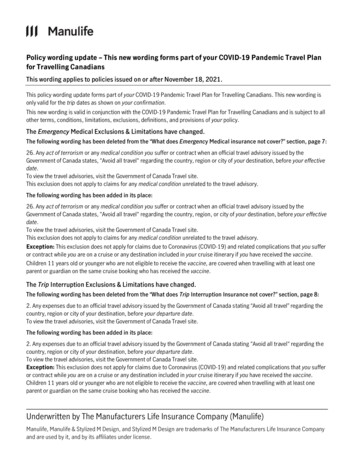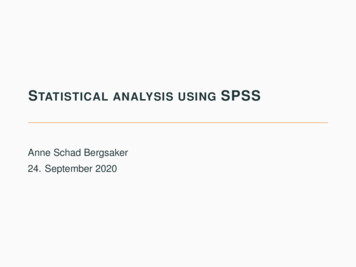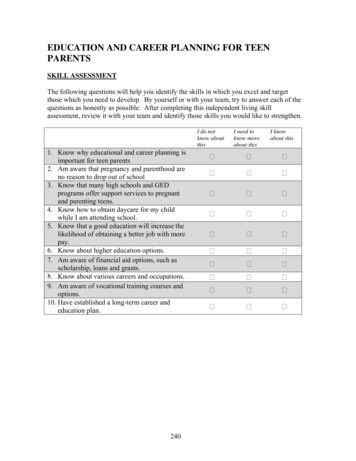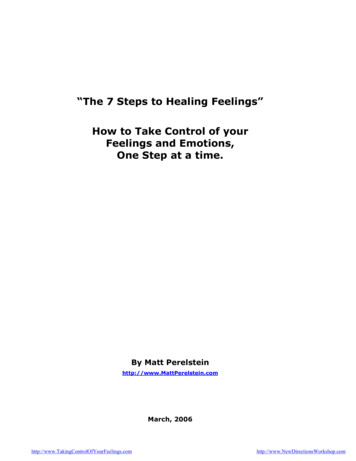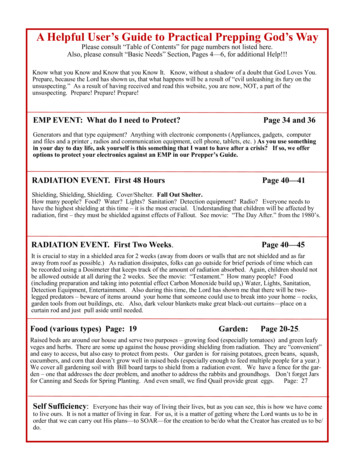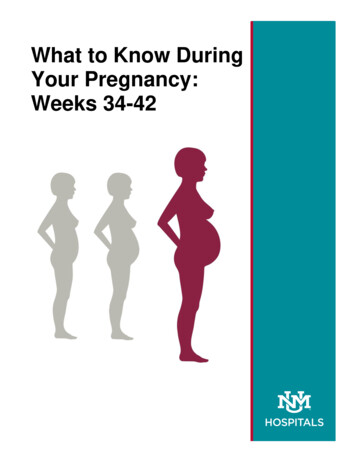
Transcription
What to Know DuringYour Pregnancy:Weeks 34-42
We look forward to caring for you, and we hope all goes well duringyour pregnancy. Just in case, here is some information on when tocall us or come to OB Triage.OB Triage is the Emergency Room for pregnant women and forwomen up to 6 weeks after birth (postpartum).Go to OB Triage right now--Less than 37 weeks with contractions or with water breaking--Any time in pregnancy or postpartum with: A blow or injury to the stomach Severe headache that has not gone away after taking Tylenol Visual changes or blurred vision Seizures or fainting Heavy vaginal bleeding Feeling something in the vagina Unable to breathe Constant chest pain Severe stomach pain--Postpartum with wound (cut) that is red or swollen or stomach that is very tenderGo to OB Triage soon--More than 37 weeks: With strong contractions every 3-5minutes or closer for 1 hour If your water breaks--More than 24 weeks with less movementof the babyCall the clinic nurse or the nurse adviceline at 1-877-925-6877 for questions orconcerns--More than 37 weeks with irregularcontractions or cramping--More than 24 weeks with vomiting 1-2times a day--Any time in pregnancy with:--Any time in pregnancy with spotting notrelated to recent vaginal exam or sex --Any time in pregnancy or postpartum with: Fever (greater 100.4) Diarrhea more than 5 times a day Vomiting more than 4 times a day Leg swelling on one side Pain with peeing or peeing muchmore often than normal Cold symptoms or sore throatToothache or earacheVaginal discharge with itch or badsmellOngoing constipationLigament pain (ligaments are thebands of tissue that connect bones,for example in your knees)Prescription refill
3What’s in This BookletCongratulations! Your baby is almost here! This booklet has informationabout Weeks 34-42 of your pregnancy.Things to Do.4During Weeks 34-36 of Your Pregnancy . 4During Weeks 37-42 of Your Pregnancy . 5All about Labor .6What Is Labor? .6Signs That Labor Is Getting Closer .6What Should I Do If I Think I'm In Labor? . 7Come to The Hospital If . 8What to Do At Home . 8What to Bring to The Hospital . 9What to Know about Pain During Childbirth . 10How Painful Is Giving Birth? . 10Why Is Labor Painful?. 10Coping With Pain Without Using Medicine . 11Using Medicine for Pain Relief . 13Common Questions. 17Breastfeeding—You Can Do It! . 19Important Phone Numbers. 20HLO Approved2/20#P2016-723
4What To Know During Your Pregnancy—Weeks 34-42Things to DoDuring Weeks 34-36 of Your PregnancyMedical Test – Group B Beta Strep CultureAt the clinic, we will test you for a common bacteria called Group BetaStrep (GBS). About 2 of every 10 women have this bacteria. It is not sexually-transmitted. It usually does not cause symptoms (like discharge or itching). We treat it during labor to protect your baby from a lung or bloodinfection. We don’t need to treat it before you go into labor.In the test, we get a swab sample from your vagina and your rectum (wherepoop leaves your body). If you have the GBS bacteria in your body, we willgive you antibiotics during labor.Do Your Pre-Admission PaperworkThe hospital needs your information before you go into labor. Please fill outpre-admission paperwork one month before your due date.Here’s how: Go to the Admitting Office on the first floor of themain hospital. Ask the information desk for directions orfollow signs to “Admitting.” If you have health insurance, bring your insurance card or Medicaidcard with you. The Admitting Office will call your insurance to tellthem to pay for the costs of having your baby. If you do not have health insurance, the Admitting Office will tellyou if you qualify and how to apply.ChildcarePlan to have someone take care of your other children while you arein the hospital.During flu season (early winter through spring months) the baby’s siblingsmay be allowed to visit the Labor and Delivery and Postpartum (after birth)areas. Before going into these areas, the hospital staff will ask questionsabout how your child is feeling. These questions will help staff knowwhether your child might spread a sickness to you or your baby. If yourchild is sick, they will not be allowed to visit you. Sometimes, if the fluseason is very bad, nobody under age 14 is allowed to visit.
5Get a Car Seat for the BabyYou must have an infant (baby) car seat for the baby to leave the hospital. It is the law that all babies younger than 1 year old must sit in theback seat in a rear-facing car seat (facing the back of the car). Thecar seat must meet federal standards. If you have Blue Cross Community Centennial, you may be able toget a free car seat and crib. Your provider has to sign a form. Youcan find the form at this link:https://www.bcbsnm.com/pdf/forms/cc crib carseat nm.pdf If you have Presbyterian Centennial, they also have a PresbyterianBaby Benefits Program. You may be able to use rewards to buy acar seat. Get more information at xDuring Weeks 37-42 of Your PregnancyGet Ready for the Birth of Your Baby Pack your bag for the hospital. (See page 9 to find out what to pack.) Keep important phone numbers handy (like the OB Triage NurseAdvice Line at 1-877-925-6877). If you go one week past your due date, we will talk about andschedule a labor induction. This means we will plan a day to giveyou medicine to help you go into labor.o We schedule inductions between 41 and 42 weeks.o If you do not have an induction at 41 weeks, we’ll do some tests.We will check the baby’s heart rate and look at the amount offluid surrounding your baby.o We usually do not recommend labor inductions before 41 weeksunless you have certain medical problems. We will go over other labor instructions and precautions with you.Rear-facing car seat
6What To Know During Your Pregnancy—Weeks 34-42All about LaborA full term (normal length) pregnancy lasts 37 to 42 weeks. Most women gointo labor during this timeWhat Is Labor?Labor is the process of giving birth to your baby. It happens when youruterus contracts to push the baby out.Braxton-HicksContractions are: Irregular Don’t come very often Last for 15-30 seconds(but sometimes up to2 minutes) They often go awaywhen you changepositions or activityReal LaborContractions are: More regular They get stronger,longer, and closertogether as younear labor They usually last30-70 seconds They don’t go awaywhen you changepositions or activity They come with othersigns of labor Your uterus is a very strong muscle. When it contracts, it helpssoften and open (dilate) your cervix. The contractions will get stronger and more painful as yourlabor continues. Normal labor can last between 2 and 24 hours.Signs That Labor Is Getting Closer Lightening: This is when the baby drops down into the pelvic bones.You might feel like:o it is easier to breathe.o you pee more often because there is pressure onyour bladder. Vaginal Discharge: Mucus and fluid coming out of your vaginamight increase. You may have thick mucus and a bloody “plug”coming from your vagina. This can be normal. Braxton-Hicks Contractions: These are contractions that help yourbody practice for labor. Once you get closer to your due date, theyget stronger and come more often. The orange box can help you tellthe difference between Braxton-Hicks contractions and reallabor contractions. Burst of Energy: You might feel more energetic because your bodyis getting ready for the hard work of labor. Remember to take sometime to rest!
7What Should I Do If I Think I’m In Labor?You should call the OB Triage Nurse Advice Line at 1-877-925-6877.Please let them know if your blood pressure has been high or if you havehad a C-Section before. Here is some information on when to call: Call when you’re having regular painful contractions for1 hour that:o come every 3 to 5 minutes (see orange box on the right).o last 1 minute each.o feel very strong.o are all the same strength. How to TimeContractionsCount the timefrom the start ofone contraction tothe start of thenext contraction.Call sooner than 1 hour if:o this isn’t your first baby and your previous labors were fast.o you live far away from the hospital. Also call if your “bag of waters” breaks (your water breaks).o Tell us if the fluid is yellow, green, or brown colored (like thebaby pooped inside).o Tell us if you are GBS positive (have the Group B Beta Strepbacteria). See Page 4 for more information on GBS.umbilicalcordplacentaNot Sure if Your Water (Bag of Waters) Broke?Usually when your water breaks, you will leak fluid until your baby is born. Here aresome things you can do to tell if you are leaking. Put a pad on your underwear to see if the pad collects more fluid. Take your underwear off and wear a skirt or towel to see if fluid is drippingdown your leg. Walk around for about an hour. If your water has broken, you will still leakand feel wet.If you think your water has broken, don’t put anything in your vagina. This makesyour risk for getting an infection higher.If you think your water has broken, ask your providers to only do vaginal examswhen absolutely necessary. This protects you and your baby from infection.bag ofwaters(amnioticfluid)cervix
8What To Know During Your Pregnancy—Weeks 34-42Come to the Hospital If:you have heavy bleeding from your vagina, like a period.you have a very bad headache, problems seeing, or pain under yourribs on the right side that doesn’t go away.you have had a C-section delivery in the past and you arehaving contractions.your baby isn’t moving.What to Do at HomeHere are some ways to make yourself comfortable at the start of your labor. Have loved ones at home with you who will encourage andsupport you. If it is night-time, try to sleep. If it is day-time, try lying down tosleep or rest. Get all the rest you can. Take a walk or move around, but save some of your energy for laterwhen contractions get stronger. Try distracting yourself. Watch movies, cook food to eat after youcome home from the hospital, make a birthday cake for the baby, ordo a craft project. Take a shower or bath. This can help you relax. Drink lots of water and fluids with calories, such as Gatorade,coconut water, or juice. This will keep you hydrated and can giveyou energy. Try to drink at least 8 ounces of fluid every hour.Do not drink caffeine (coffee, black or green tea, coke or soda,energy drinks). Eat something. Labor takes a lot of energy.Do not eat foods that are very heavy, fatty, or greasy. Drink lots of water and fluidsDon’t panic! You can do this. Your body was made for this.You are strong!
9What to Bring to the HospitalThings for Labor Food and drinks for your visitors and yourself (the hospitalcan give you meals, juice, and ice) Camera or phone for pictures (don’t forget chargers!) Glasses, contact lenses, and cases Things to help make you comfortable like massage oilor music Your own pillow. (Put a pillowcase on it that is not white soyou know it is yours.) Robe, slippers, and socks Chapstick, hair ties or clips, comb, brush, toothbrush,toothpaste, shampoo If you are getting an induction, you may want to bring things to keepyou busy before labor starts, like cards, games, a laptop, or movies.Things for After the Birth Bra (nursing bra if you’re breastfeeding) Clothes to wear home Clothes for the baby—T-shirt, hat, socks, blanket, sleeper, outfit Newborn car seatBring a toothbrush, deodorant,toothpaste, and hair products
10What To Know During Your Pregnancy—Weeks 34-42What to Know about PainDuring ChildbirthHow Painful Is Giving Birth?You’ve probably heard stories about giving birth. Birth is very different foreach person. Each person has a different amount of pain. The kind of pain you have and the amount of pain you have changesduring your labor.Why Is Labor Painful?Labor hurts because your body is working hard. Your uterus is pushing thebaby down and stretching your cervix (the opening of your uterus). Each time the uterus muscles flex, you may feel pain like astrong cramp. As your cervix and vagina stretch and open, you might feel astretching, burning pain.Although contractions are painful, you can rest in between them. Mostcontractions last 30 to 60 seconds.Remember!Nobody knows ahead of time how painful or difficult your laborwill be. Knowing what you want is a good place to start.When you are in labor, be open and willing to change. Trust yoursupport persons and caregivers to help you make decisions thatwork for you.The next sections will give you more information to help you decidewhether to use medicine and what kinds of medicine to use.
11Coping with Pain Without Using MedicineThe less tense and afraid you are, the less painful your labor will be. Threethings can help you labor successfully without using medicines: Know what to expect. Believe in yourself! Have emotional support and coaching during your labor.What Can I Do Before Labor? Stay active during your whole pregnancy. Regular exercise willkeep you strong to get through labor. Take childbirth classes. The more you know, the less you fear. Fearmakes pain hurt more. Have a birth coach or doula. Their job is to support you duringlabor and pregnancy. This may help you cope with pain andfeel better.What Can I Do During the Beginning of Labor? When labor begins try to rest or sleep. Save energy for when harderlabor starts. In early labor go for a walk or dance. The more you move, the lessyou hurt. Drink lots of fluids so you don’t get dehydrated. Eat small meals or snacks if you are hungry. Take a warm shower or bath. Have support people with you.When labor starts, try torest or sleep.Believe in yourself!You can do it!
12What To Know During Your Pregnancy—Weeks 34-42What Can I Do During Active Labor?Find your rhythm. Women who do well often rest between contractions ormove to help cope with contraction pain. Each person has their own rhythmthat works. You may: Rest between contractions by being still or by rocking gently. Focus on your natural breathing. Awareness of breath relaxes you. Change positions often. Don’t be afraid to make noise. You might moan, hum, or repeatcomforting words over and over as you go through each contraction. Try using a birth ball. Use the shower or bath tub to help your body relax. Believe you can do it. You can! Remember why you are doing this. Your baby will be here soon!What Can My Birth Partner Do During Labor? Help you find your rhythm and then help you during each part. Give you a back rub or hold your hand quietly. Offer you ice chips, water, or juice. Help you change positions and support your body. Keep the lights low and play soft music. Put a cold washcloth on your forehead. Put a warm washcloth on your lower back or belly. Talk you through contractions, supporting your movements andyour noises. Cheer you on!What Can My Provider Do During Labor? Answer your questions. Check your progress and give you direction and support. Discuss pain medicine if you want it.
13Using Medicine for Pain ReliefThe most common pain medicines are: Intravenous (IV) Pain Medicines: pain medicines that go intoyour veins Nitrous Oxide (laughing gas): a gas that you breathe in through amask to lessen your labor pain Epidural: a small tube that goes into the lower part of your back.It gives you medicine to lessen your pain from contractions.What Are the Pros and Cons of IV Pain Medicines?Pros: They relieve pain fast. You usually feel less pain in 2 to 10 minutes.They go directly into your blood through an IV.They may help you relax and be more comfortable.They don’t usually slow down your labor.Cons: IV pain medicines don’t last long. They usually relieve pain for20 to 90 minutes. They may cause itching or nausea (feeling like you’re going tothrow up). They might make you feel really “out of it” or sleepy. IV pain medicines don’t take away all of the pain or make your bodynumb. But they may make contractions less painful.If you get IV pain medicines close to the time you deliver your baby,your baby might have trouble breathing or breastfeeding right afterbirth. If you get a lot of IV pain medicine during labor, this riskgoes up.IV Pain Medicines
14What To Know During Your Pregnancy—Weeks 34-42What Is Nitrous Oxide?Nitrous Oxide (also called laughing gas) lessens pain during labor. You puta mask on your face and breathe the gas in before a contraction begins. You can use Nitrous Oxide before an epidural.You cannot use it with IV pain medicines.You cannot use it if you have a Vitamin B-12 deficiency.Pros: It is considered safe for you and your baby.It can make you feel less worried.Cons: You may feel sleepy, dizzy, or unsteady while using Nitrous Oxide.You may feel nauseous or throw up.Nitrous Oxide does not take away all of the pain or make your bodynumb. But it may make contractions less painful.Nitrous Oxide
15What Is an Epidural?An epidural is a small tube that goes into the lower part of your back andgives numbing medicine to your nerves. This lessens the pain ofcontractions. It numbs your belly and legs.How Does the Anesthesia Doctor Put In an Epidural?Your anesthesia doctor will talk with you before putting in an epidural tolearn more about your medical history and pregnancy. If you and yourdoctor decide on putting in an epidural: You will sit on the side of the bed or curl up on your side. The doctor will numb your skin and then put an epidural tube in thelower part of your back, between the bones in your spine. The doctor will put numbing medicine through the tube to make youmore comfortable during labor. A pump will be connected to the tube to give you more numbingmedicine during labor.After the epidural goes in, your nurse will put a tube in your bladder to drainyour pee during your labor. There is a small risk of getting a bladderinfection with a tube in your bladder.EpiduralBladderAfter birth, the nurse will remove the epidural tube and the numbness willstart to go away. You’ll be able to move your legs and walk in a few hours.How Well Does an Epidural Work?For most people, an epidural works very well. An epidural takes 15 to 20 minutes to lessen your labor pain. Many people are so comfortable they can talk, watch TV, or sleep. About 1 in 100 people may need an epidural adjusted or replaced ifit is not working well.What Are the Benefits of an Epidural? Epidurals are the most effective way to lessen the pain during labor. An epidural can help you rest and relax. If your labor lasts a long time, an epidural may help youdilate quicker. Less medicine reaches the baby compared to IV pain medicines. If you need a C-section, your epidural can make you numb forthe surgery.A catheter (small tube) willdrain pee from your bladder.
16What To Know During Your Pregnancy—Weeks 34-42Are There Risks of Getting an Epidural?Common Side Effects of an Epidural The medicine can lower your blood pressure. It can make you itchy. It can make you nauseous or throw up. You could get a fever during labor, which may mean more tests foryou and your baby. You may have a small bruise where the tube is placed. You may need medicine to make your contractions stronger. It may be hard to feel your contractions when you need to push.If so, pushing may take longer. If you are having a lot of troublepushing, you care team may need to use a special vacuum to helppull the baby out.Rare Risks of an Epidural There is a small risk of infection or bleeding (1 in a million people). The epidural tube can slip into a vein or the spinal fluid in your back.This may make it harder to breathe if you get too numb. There is a small risk of damage to a nerve or tissue (1 in 20,000people) that could cause numbness, tingling, or a nerve not working(paralysis) even after the epidural wears off. You may get a headache after you deliver your baby that needstreatment before you leave the hospital. The baby may have trouble latching to breastfeed.What Else Should I Know about Epidurals? Epidurals do not increase your risk of needing a C-Section. Epidurals do not cause long term back pain. When you get an epidural, your legs will be numb and tingling, soyou cannot walk around. You can move around in bed (hands andknees, sitting up) to a comfortable position for labor and pushing.
17Common Questions1. How many people can I have with me during labor?This decision is up to you. You should have people there who will love andsupport you in labor. We usually suggest 1 to 2 people with whom you feelvery comfortable. Having too many people in the room is sometimesdistracting and not helpful to the person in labor.During the flu season (early winter through spring months), siblings canusually visit the Labor and Delivery or Postpartum (after birth) departmentsonly if they are not feeling sick.2. Will I get an IV (intravenous)?Not always. We will give you an IV if: you are dehydrated (from vomiting or not being able to drink a lot offluid) you need medicines or want to use pain medicines you have anemia (low iron in your blood, low blood count) you have a history of bleeding too much after giving birth we are concerned about the babyEven if you have an IV, you can sometimes have a “saline lock,” whichmeans you are not connected to the IV bag or pump. This makes it easier tomove around.3. Will I be connected to a monitor the whole time?When you arrive at OB Triage or Labor and Delivery, we will use amachine called a monitor to check your baby’s heartbeat for about20-30 minutes.We continue monitoring your baby the whole time if: you had a C-section in the past you are using medicine for pain you are using medicine to make you have contractions(labor induction) we have concerns about your babyIf these do not apply to you and you and your baby are healthy, then wewill connect you to the monitor every once in a while, but not for thewhole time.The monitor will looklike this.
18What To Know During Your Pregnancy—Weeks 34-424. Will I have an episiotomy?Words to Know Episiotomy: a smallcut that makes theopening of yourvagina biggerAn episiotomy is a small cut that makes the opening of your vagina bigger.Providers should only do an episiotomy if there is a problem with the babyor mother. Episiotomies are very rare.Your provider can also show you exercises to help stretch your vaginaltissue to get ready for pushing.5. How long will I stay in the hospital after birth? If you have a vaginal birth, you will stay in the hospital for at least1-2 days after giving birth. The length depends on what time yougive birth and if you or your baby have any medical problems. If you are a new parent or if you are getting help with breastfeeding,we recommend that you stay for 2 days. If you have a C-Section, you may stay for 3-4 days.Postpartum: the timeperiod after birth6. Will the baby stay with me in the hospital?If you and your baby are healthy, your baby will be with you in your roomthe whole time after birth.If you have a C-section, your baby can be with you if another adult is thereto help you for the first 12 hours.7. Can I have visitors after I give birth?We try to give patients and their babies time to rest after giving birth whenthey are in the postpartum area.One support person can stay with the patient and baby at all times. Thisperson will get an arm band when the baby is born.Visitors can come between 5am and 9am and between 12pm and 10pm.8. What treatments and tests will my baby getat the hospital?After your baby is born, doctors recommend: Eye ointment to protect against infections A Vitamin K shot to protect against too much bleeding A Hepatitis B vaccine A blood test to check for genetic problems9. When do I see my provider after my baby is born?We encourage you to schedule two visits at these times: 2 weeks after birth 6 weeks after birthAt these visits you may get a physical exam. We will talk more aboutyour birth and how things have been going postpartum (after birth). We willalso talk about birth control. If you want an IUD, it can be inserted at your6 week visit.
19Breastfeeding—You Can Do It!Everyone at UNM wants to help you breastfeed! Ask for help if you need it.We have breastfeeding support nurses and a special clinic to support you.Breastfeeding Resources UNM Lactation Supporto Call our Lactation Hotline 272-MILK (272-6455). Thishotline is for nurses, doctors, and patients to talk to any of ourLactation consultants. Just leave a message with yourconcerns or issues. We return all messages within 24 hours.o Visit our reastfeeding.shtmlo You can make an appointment at the UNMH Outpatient LactationClinic at 272-0480. La Leche League of Albuquerqueo For English, call their helpline at 505-821-2511. For Spanish,call Cindy at 505-867-1789. These numbers are available 7 daysa week from 9am-7pm.o Email them at albuquerquelll@gmail.como Visit their Facebook page:www.facebook.com/groups/AlbuquerqueLLLo Visit their website: www.lalecheleague.org Breastfeeding and New Mom Support Group: Meets Wednesdaymornings from 10am-12pm (except holidays) at Dar A Luz BirthCenterB.F.F. (Breastfeeding Friends Network)o Wednesdays 5pm-6:30pm at Young Children’s Health Center(306 San Pablo SE)o Visit their Facebook page: http://www.facebook.com/BFFnetwork UNM Breastfeeding Taskforce: www.breastfeedingnewmexico.org Dr. Jack Newman: www.drjacknewman.com www.breastfeedingbasics.com www.kellymom.comBreast PumpsYou might be able to getelectric breast pumpsand some breastfeedingsupplies through yourhealth insurance. Callyour insurance companyor Medicaid formore information.
Important Phone Numbers 1-877-925-6877: Emergencies –OB Triage nurse advice line (see the nextsection) or UNM Hospital OB Triage: 272-2460272-2245: University Center for Women’s Health (at UNMH)925-CARE (925-2273): UNMH Women’s Primary Care (on Eubank)272-8913 Women’s Ultrasound/Imaging272-2900: Westside Family Health861-1013: Belen First Choice Clinic865-4618: Los Lunas First Choice Clinic248-7703: Albuquerque Indian Health1-800-773-3645: New Mexico Coalition Against Domestic Violence Hotline247-4219: S.A.F.E. House (for Domestic Violence) If you have an emergency or if you are in labor, call theNew Mexico Coalition Against Domestic Violence Hotline: 1-800-773-3645OB Triagenurse advice line at 1-877-925 6877House(for Domestic Violence): 247-4219You canS.A.F.E.call at anytime.OB Triage is the part of the hospital that takes care of pregnantpatientswho are in labor or have an emergency. It is always open. New Mexico Coalition Against Domestic Violence Hotline: 1-800-773-3645OB Triage is on the 4th floor of the Barbara and Bill Richardson S.A.F.E. House (for Domestic Violence): 247-4219Pavilion(the new part of the hospital). Things to Know about OB Triage Call OB Triage nurse advice line before you go there at1-877-925-6877. Sometimes the nurse can help you on the phone.OB Triage staff will see the patients who are the sickest or are inlabor first.2 people may be with you in the triage room.Bring a snack and something to drink in case you have to waitfor a long time.Providers send most patients from OB Triage to Labor andDelivery when they are actively in labor. This is called “active labor”and is when the cervix is open (dilated) about 5-6cm.If you do not have an emergency and are not in labor, buthave questions, concerns, or are sick:Call your clinic.When the clinic is open—Call your clinic to talk to a nurse or leave a message.They’ll try to call you back on the same day.During weekends and when the clinic is closed—You can call your clinic andleave a message on the nurse line. Someone will call you back during normalbusiness hours.
5 Get a Car Seat for the Baby You must have an infant (baby) car seat for the baby to leave the hospital. It is the law that all babies younger than 1 year old must sit in the back seat in a rear-facing car seat (facing the back of the car).
